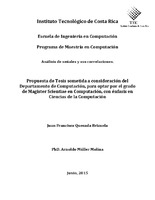Análisis de señales y sus correlaciones
Resumen
Continuous improvement, preventive maintenance and machine fault prediction are the main focus of engineers that develop such machines today. Through signal analysis, correlations and anomalies can be found which would facilitate their analysis. Creating a tool that enables engineers to solve these problems is desirable.
These analyzes involve a lot of computational complexity, are heavy and generally take many hours of work. It is necessary to create a method that is efficient and can be effectively used to perform the analysis.
The process consists of defining a distance function to compare signals effectively. The signals must be segmented and, by using a clustering algorithm, clusters of signals are going to be created, one at a time. This is intended to extract a behavior of a signal as a word. By organizing the corresponding words of different signals at the same time; we can create the documents which are the input to an algorithm of topic models that let us find anomalies and co-occurrences in the signals.
For example if you are going to perform the analysis with data from a car engine, we could find topics such as acceleration, braking or idling. These would be automatically determined by the system. We would probably have several examples for each of these, such as when the engine is cold, when it reaches its operating temperature and other variables. Changing the settings of the algorithm can create more issues about acceleration behavior. On the other hand, you can determine when a component begins working improperly without causing an immediate system failure, but that in the long term could create catastrophic failure.
This thesis project implements a system to discover common patterns and signal anomalies. The process involves setting various parameters such as the signal length, the signal normalization, the selection and optimization of distance functions and the respective distance ranges. For the signal groups, configuration parameters for the discovery algorithms of topics are also very relevant.
Descripción
Proyecto de Graduación (Maestría en Computación) Instituto Tecnológico de Costa Rica, Escuela de Ingeniería en Computación, 2015.
Compartir
Métricas
Colecciones
- Maestría en Computación [119]


